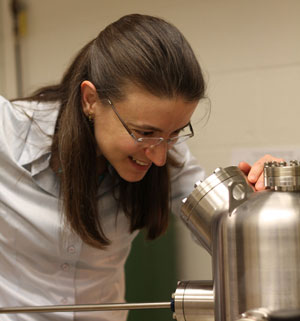
Bilge Yildiz: New insights into material surfaces advance energy conversion technologies
Materials are key enablers in any engineering project. Bridge builders, who once worked in stone, and then in steel, can now draw on carbon fiber, polymers, and composites with outstanding strength, weight and other characteristics that extend the engineer's capabilities.
Engineers developing advanced energy technologies like fuel cells, synthetic fuel productionsystems, and new-generation reactors will benefit from novel materials knowledge being developed at NSE's Laboratory for Electrochemical Interfaces, headed by Bilge Yildiz, the Norman C. Rasmussen Assistant Professor of Nuclear Science and Engineering. Her team is working towards better understanding of the surface and interfacial properties of oxides, and learning to tailor the oxides' physical properties to make them highly active in fuel cell reactions, and more resistant to corrosion in reactor applications.
An especially exciting area of inquiry for Bilge Yildiz's team is the use of lattice strain (a slight displacement of the atoms in a material's lattice structure) to alter the properties and boost the performance of oxides subjected to high temperature and reactive environments in fuel cells and other nuclear energy systems.
"The purpose is to assess how strain can alter the efficiency of devices like fuel cells, or the lifetime of structural materials in reactors. We investigate how critical properties, like surface reactivity and diffusivity of oxide ions, can be controlled by strain," explains Yildiz, principal investigator at the Laboratory, which has received funding from an MIT Energy Initiative Grant, the Department of Energy (DOE) Office of Basic Energy Sciences, and a Nuclear Regulatory Commission Faculty Development seed grant.
Yildiz's work on mechano-chemical coupling in surface chemistry, reactivity, and ion conduction is also being supported by her 2011 National Science Foundation Faculty Early Career Development (CAREER) award, the NSF's most prestigious junior faculty award, which recognizes her outstanding research, excellence in education and integration of the two.
The Laboratory is probing the surfaces of solidoxide fuel cell electrodes in their reactive environments, using an array of newly developed analytical and metrology equipment, which now permits them for the first time to see into the previously unknown atomic and electronic structure of oxide surfaces at high temperatures. This includes a one-of-a-kind scanning tunneling electron microscope capable of structural and electronic interrogation at temperatures of 700 degrees C in reactive gases, coupled with an X-ray photoelectron spectrometer for chemical analysis.
This equipment, in conjunction with first-principles simulation techniques employed at the Lab, recently yielded new insights into the surface activity of solid oxide fuel cell cathodes at high temperatures and as a function of strain. "The integration of theory and experimentation is an important step towardsadvancing our understanding of how the surface staterelates to the oxygen reduction activity on oxide cathodes," explains Yildiz. "It all leads towards a better ability to 'tune' the cathode surface behavior, by means of strain or other structural and chemical attributes."
Both the ion conduction and the surface reactivity are critical engineering factors, notes Yildiz. "In fuel cells, you want fast surface reaction and ion diffusion, so you're looking for the fastest strain. When you want to prevent corrosion in a reactor, you want slow diffusion. We're studying different material structures for different functions." Yildiz's work on corrosion activity is now also supported by the Consortium for Advanced Simulation of Light Water Reactors, the first energy innovation hub initiated by the DOE, and by the BP Materials and Corrosion Center at MIT.
By developing this molecular-level knowledge, Yildiz and her associates hope to enable new levels of control of properties in future fuel cells and reactors. The findings could enable solid oxide fuel cells to operate at lower temperatures for better economic viability, or help designers improve the corrosion resistance of structures in nuclear plants and make more accurate estimates of their lifetimes.
As Yildiz puts it, "We're developing a smaller-scale understanding of how to control material properties, which hopefully will contribute to a larger-scale enhancement of energy technology performance.'"
“In fuel cells, you want fast surface reaction and ion diffusion, so you're looking for the fastest strain. When you want to prevent corrosion in a reactor, you want slow diffusion. We're studying different material structures for different functions.”
Written by Peter Dunn
Photos by Despoina Chatzikyriakou
